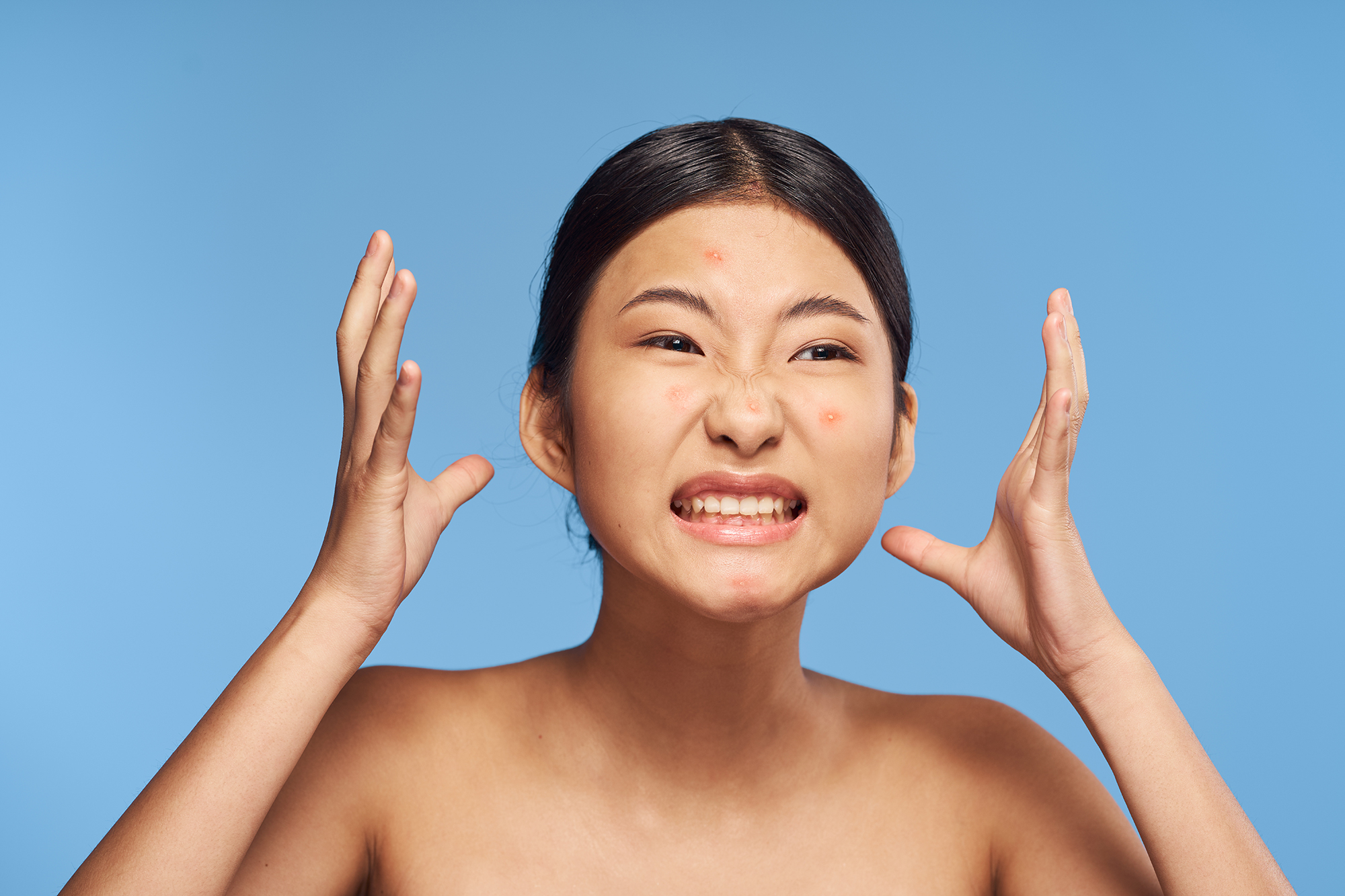
Chronic stress can cause acne, psoriasis, eczema, alopecia areata & even skin tumors. Learn more about the relationship between stress & skin.
Almost all of my clients have a stress response that is out of whack. Concurrently, almost all also have some kind of skin issue.
This post explains how stress causes a bunch of problems for your skin.
Psychological stress increases your stress response, but it is far from the only way to activate it. See the full list of ways that our stress response gets activated.
It is known that acne is made worse by emotional stress [1]. This post is going to dive into the mechanics of it.
CRH or Corticotropin-releasing hormone is the first part of your stress pathway. It’s the most studied substance in the stress pathway with regard to skin health [2].
CRH is believed to be an important cause of acne, psoriasis, eczema, alopecia areata, skin tumors and hives (urticaria) [2].
CRH, ACTH, a-MSH, and ß-endorphin and their receptors can be generated and secreted in various cells found on your skin (epidermal and hair follicle keratinocytes, sebocytes and mast cells). ACTH, a-MSH, ß-endorphin are products of CRH production [2].
The stress response pathway increases sebum production and this causes acne by making the skin more hospitable to acne producing bacteria and inflammation (from squalene) [3].
P acnes, the bacteria that causes acne, use sebum as a fuel source [4].
Indeed, sebum was 59% greater in people with acne (particularly squalene). Increased sebum (particularly squalene) causes inflammation and blackheads [3].
There are various theories as to why the stress response increases sebum production.
CRH increases sebum (oily secretion) production [2, 5]. One mechanism is by CRH increasing testosterone in the skin [5]. P. acnes also increases CRH in the skin [6].
ACTH also increases sebum indirectly by increasing adrenal male hormones (DHEA, Androstenedione, Androstenediol, Androsterone, DHT [7]) [5]. DHT not only increases sebum production but also proinflammatory cytokines in acne [8].
MSH and beta-endorphins (increased by CRH) also increase sebum (MSH is controversial). MSH synergizes with testosterone and progesterone to produce sebum secretion by an unknown mechanism [5].
Substance P, increased by stress, also influences a bunch of events that lead to increased sebum [9]. Substance P synergizes with a variety of inflammatory cytokines to increase acne [1].
CRH causes less VEGF in the skin [2]. VEGF promotes hair growth and can, therefore, result in reduced hair growth or baldness.
CRH inhibits the growth of hair cells and melanin producing cells (which cause you to tan). However, it also inhibits apoptosis of melanin cells and stimulates the production of hair cells [2].
Theoretically, this means that you will burn more easily. The melanin cells are there to protect you from the sun (UV) being able to damage your DNA [2].
Cortisol inhibits skin fat (lipid) synthesis and secretion in the skin, which is needed for an effective skin barrier [2].
Also, in animal models, stress has shown to inhibit antimicrobial peptide production and increased susceptibility to severe skin infections [2].
So fewer lipids and antimicrobial peptides in your skin will allow infections – including fungal – to fester. So if you have a skin condition caused by fungi (tinea, dandruff, etc…), activation of your stress response could be a cause [2].
Inhibition of CRH and cortisol returned antimicrobial peptide level to normal and improved the severity of infections [2].
With regard to inflammation, we see mixed effects from CRH and its downstream products. I’d say it’s overall for the worse, but genetics has a large role in how the stress response affects your skin.
CRH causes the release of IL-4, IL-6, IL-10, and IL-13 from skin cells and mast cells. All these have the effect of reducing the skin immune system and inflammation. (Serotonin can reduce mast cell activation in the skin) [2].
By activating mast cells, you feel more flushed. Mast cell activation plays a central role in skin issues such as eczema, itching, and hives [2].
CRH decreases IL-18, the proinflammatory cytokine, while ACTH increases it [2].
In people, CRH, ACTH, a-MSH were increased in the skin in Alopecia Areata. However, they had insufficient cortisol. So the first part of the stress pathway increased, but not the last part. The effect of CRH on mast cells contributes to less hair growth [2].
In mice, vasopressin and POMC were increased. The mice showed a significantly weakened systemic HPA responsiveness to acute stress and exhibited an imperfect adaptation to chronic psychological stress [2].
Stress suppressed the skin immune system overall and it can’t fight cancer as well. Also, CRH enhanced tumor cell growth and angiogenesis and can cause or contribute to melanoma [2].
The increased stress levels of the modern era are one reason why skin cancer has been such a problem in this century, even though we’ve evolved with the sun for billions of years. This is even though we bath ourselves with sunscreen and stay indoors mostly, as opposed to our evolutionary history.
CRH and mast cell activation from it play an important role in contact dermatitis, which is a rash you develop from a foreign substance. CRH increases the immune response to foreign substances and also increases inflammation (Nf-kB) in hair cells [2].
Hypothalamus and skin disease.
